Poring over my photo archives from three years ago, I reflect that my life is now much less active. Having given up our second home in Illinois, we are more homebound. Excursions are mostly for shopping, choir practice, church and of course, visits to the dentist and various doctors. Our early morning walks into the adjacent Wounded Wetlands highlight each day.
We started out the month of May, 2016 in Illinois. Our son-in-law hosted their traditional backyard Cinco de Mayo pig roast with over 100 people in attendance. Since it is also a birthday party for our daughter, donations to a local charity are requested in lieu of gifts. Spring migration was underway. At every opportunity, MaryLou and I visited the numerous municipal parks and county forest preserves.
At Bliss Woods in Sugar Grove we found Yellow Warblers in full song:
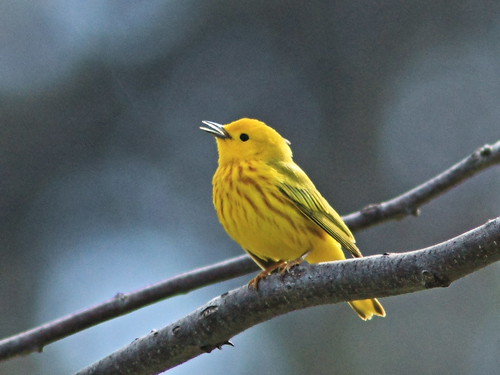

We encountered one Orchard Oriole:
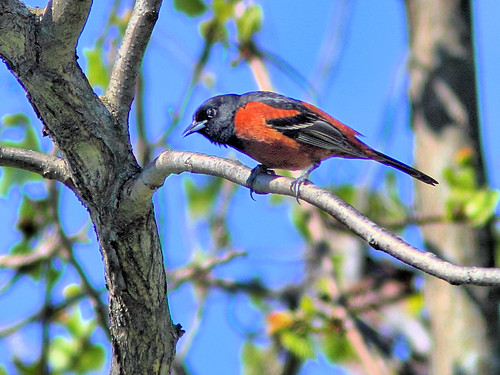
Common Grackles in Midwestern US were formerly called "Bronzed Grackles" as opposed to the eastern "Purple Grackles," as I knew them as a kid in New Jersey. They were originally considered separate species. This photo illustrates its iridescent brown back:

At Jones Meadow Park near our condo in North Aurora, Flocks of Sandhill Cranes were arriving and passing overhead:

This Virginia Rail was a real treat as it posed in a cattail patch:
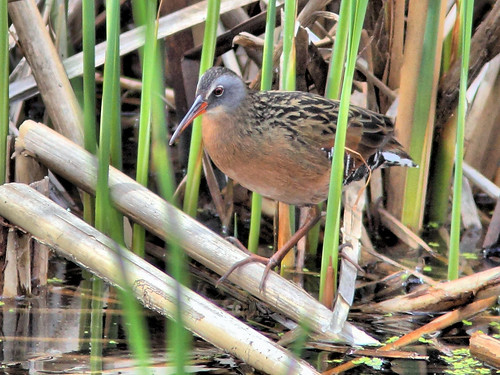
A Canada Goose tends to its goslings. This photo was taken from some distance away, as they can become violently aggressive in defense of their young:

A male American Goldfinch is reflected on the surface of a brook:

We visited the Japanese Garden at Fabyan Forest Preserve in Geneva, providing some of my favorite photo opportunities:
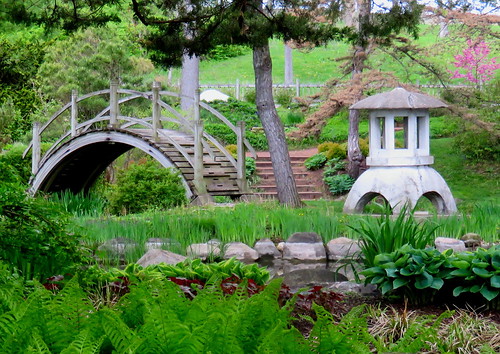
Blossoms enveloped a small outbuilding in the garden:
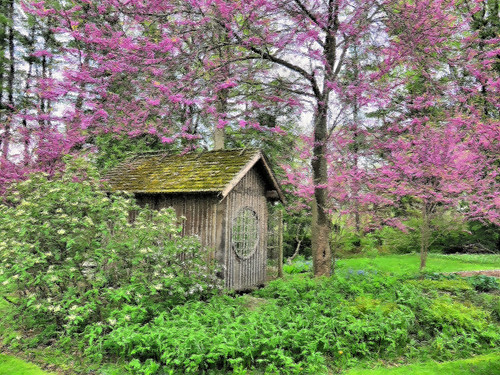
There, a Great Horned Owl tended its owlets...

...and a beautiful Yellow-throated Warbler sang in a treetop:

Oh, my-- this only brings me up to the 6th of the month-- So many more photos to review! Scarlet Tanager, a Rose-breasted Grosbeak and an Indigo Bunting on April 12:
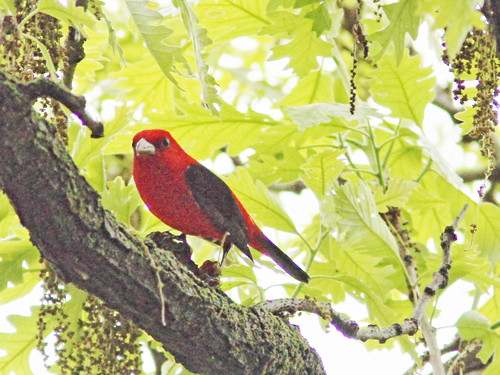


On May 15, the day before we returned to Florida, a Baltimore Oriole perched nearby:

Back home, MaryLou is ahead of me as she enters our local wetlands:
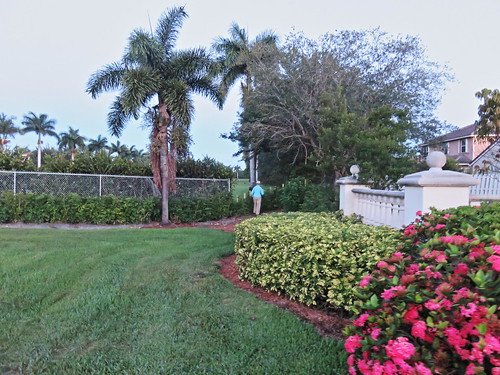
A Great Egret takes flight:

A little Blue Heron and a smaller Green Heron interact:

A young doe prances across the gravel track:

Before sunrise, a storm is forming to the west over the Everglades:
 = = = = = = = = = = = = = = =
= = = = = = = = = = = = = = =
Linking to Misty's CAMERA CRITTERS,
Linking to Eileen's SATURDAY'S CRITTERS,
Linking to SKYWATCH FRIDAY by Yogi, Sylvia and Sandy
Linking to WEEKEND REFLECTIONS by James
Linking to BirdD'Pot by Anni
Linking to Our World Tuesday by Lady Fi
Linking to Wild Bird Wednesday by Stewart
Linking to Wordless Wednesday (on Tuesday) by NC Sue
Linking to ALL SEASONS by Jesh
Linking to Fences Around the World by Gosia
________________________________________________
Please visit the links to all these memes to see some excellent photos on display
________________________________________________
My post in late February "A small heron rookery" described the damage done to the nest trees in the local rookery by Hurricane Irma, which struck in September, 2017. This was followed by the intentional removal of many trees along the adjacent canal, as some had been blown over to partially obstruct it and others had grown out over the water. A major portion of the rookery, an area which previously was a favored nesting site by 6-8 pairs of Yellow-crowned Night-Herons, had been clear-cut by the regional water management authority.
This particular tree was partially uprooted by the hurricane and extended well out into the water of the storm-water drainage canal. In April of 2018, A pair interacted on the partially submerged branches of the fallen tree:

Their nest was placed rather precariously over the water on the horizontal trunk:
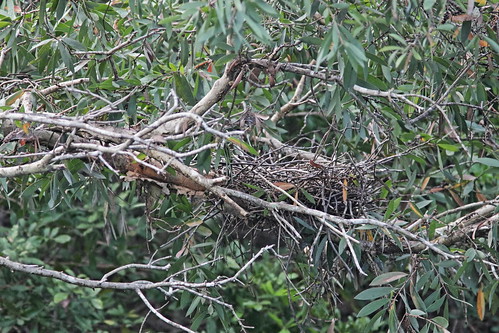
The next day, an adult Yellow-crowned Night-Heron was sitting low on the nest:

I subsequently photographed eggs in the nest, but had to fly back out to Illinois to close the sale of our condo. A few weeks later I returned to Florida and found only a single immature heron in the rookery. Here it was in early July, 2018:
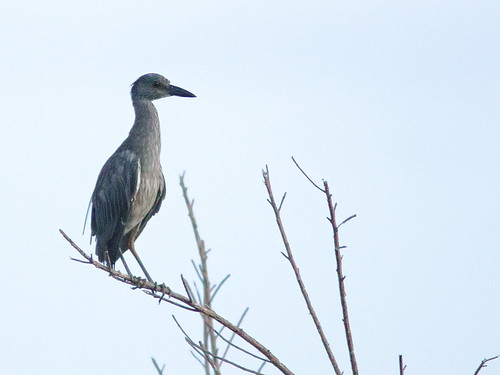
In August, 2018 it had begun to molt into adult plumage:

I cannot say for sure that it is the same bird, but this is a sub-adult roosting very close to the nest site in the condemned tree, marked for removal (October 18, 2018):
 After the cutting, only one pair out of the several night-herons which had gathered in the damaged area stayed on and built a nest, as documented in my earlier post. A single immature bird remained to roost next to the stump of the only tree which held a nest in the previous spring. Was it the same bird? Did it hatch from the nest in the missing tree? Here it is in December, 2018. Note that its head is streaked, a feature which may persist into its second year of life:
After the cutting, only one pair out of the several night-herons which had gathered in the damaged area stayed on and built a nest, as documented in my earlier post. A single immature bird remained to roost next to the stump of the only tree which held a nest in the previous spring. Was it the same bird? Did it hatch from the nest in the missing tree? Here it is in December, 2018. Note that its head is streaked, a feature which may persist into its second year of life:

For weeks, it was the only immature bird in the rookery, seen here on February 12, 2019:

As spring approaches, adults in breeding condition develop head and back (occipital and scapular) plumes. Their heads turn clear yellow and their legs become red:

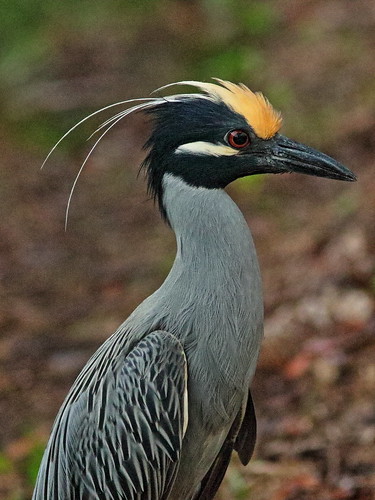
This takes us up to the present. Inexplicably, on March 9, 2019, the pair which was building the nest (as documented in my earlier post) simply disappeared. Suddenly the rookery was abandoned-- almost. The sub-adult was reliably present every day, roosting next to the site formerly occupied by the nest tree. Then it also disappeared for a few days and I concluded that the rookery had indeed been abandoned.
However, on April 16, the (same?) sub-adult reappeared. This time it was accompanied by an adult in bright breeding plumage which performed a courtship display!
Note the absence of head plumes on the female:

The male has full plumes and red legs:
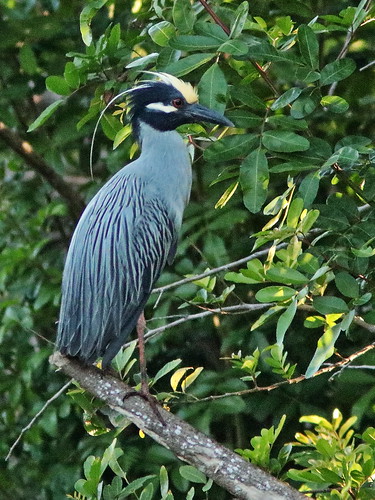
He displayed to the somber female, and also started carrying in nesting material to an area of the rookery which was left undamaged:

As a bonus, a bonded pair of Green Herons appeared. Although I failed to obtain a photo of the action, a third one showed up and was chased away. Luckily, it landed in a small tree right next to me. This is the interloper. Note yellow legs as opposed to the members of the pair, which were in breeding plumage and had red legs. The emerging leaves of the Mahogany tree enhanced this portrait:
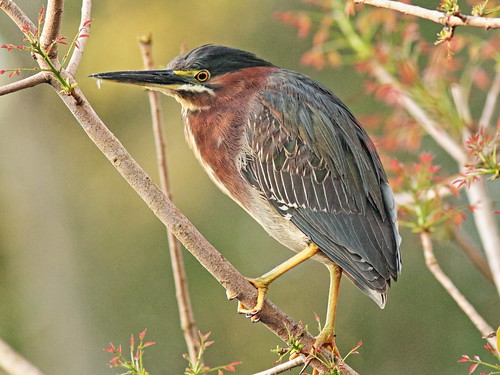
Since I plan to be away for week after Easter, I have prepared this in advance. A few other images from the past few days--
Horned Bladderwort emerged in the lakeside marsh. This is a carnivorous plant which traps small insects and other tiny organisms, digesting them in its "bladders," underwater tubes which snap open and suck in the prey. This allows it to survive where the environment is poor in nutrition. Its foliage and seeds are poisonous:

Interestingly, another species of bladderwort, Little Floating Bladderwort, occupied the same patch of shallow open water:

The sky was pink before sunrise in the ATV-scarred north Wet Prairie:

A Solitary Sandpiper cast a nice reflection as it foraged in the tracks left by the "wreckreational vehicles:"

At a high spot in the wetlands, the pumpkin-like fruit of a wild exotic Surinam Cherry brightened the scene:
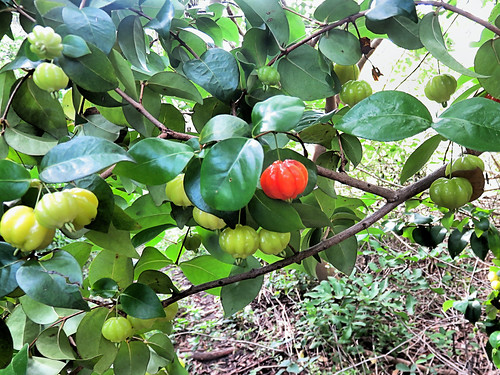
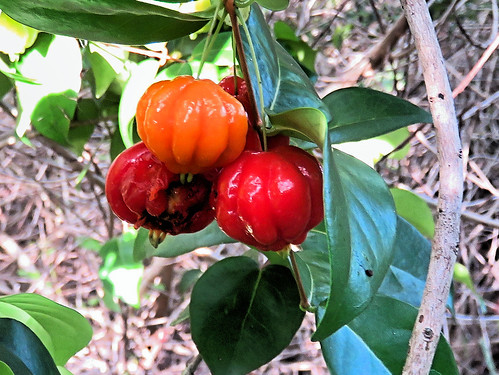
= = = = = = = = = = = = = = =
Linking to Misty's CAMERA CRITTERS,
Linking to Eileen's SATURDAY'S CRITTERS,
Linking to SKYWATCH FRIDAY by Yogi, Sylvia and Sandy
Linking to WEEKEND REFLECTIONS by James
Linking to BirdD'Pot by Anni
Linking to Our World Tuesday by Lady Fi
Linking to Wild Bird Wednesday by Stewart
Linking to Wordless Wednesday (on Tuesday) by NC Sue
Linking to ALL SEASONS by Jesh
________________________________________________
Please visit the links to all these memes to see some excellent photos on display
________________________________________________








































